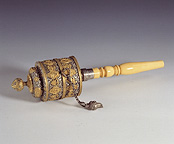
Item: Miscellaneous - Hand Prayer Wheel
| Origin Location | Tibet |
|---|---|
| Date Range | 1800 - 1899 |
| Lineages | Buddhist |
| Material | Silver |
| Collection | Private |
| Catalogue # | Tibet Museum, Lhasa |
Classification: Object/Concept
The prayer wheel, a popular device in Tibet and across the Himalayas, was originally intended for the Naga world, where the serpent-like creatures were too lazy to engage in meritorious acts. A coil of mantras (mind-protecting spells associated with an enlightened deity), often hundreds of thousands, printed from woodblocks on long sheets of paper, are rolled and placed within the cylinder. An individual spins the wheel, using the lead weight on the end of the chain to accelerate and sustain the spinning. Prayer wheels come in all sizes, some hand-held; others designed for tabletop or other stationary use. The hand-held prayer wheel, crafted of silver with partial gilding, clearly belonged to a person of high rank. Due to years of handling, the ivory handle has developed a warm patina. The body of the wheel is inscribed with sacred syllables of the All-seeing Lord (Avalokiteshvara). (Text courtesy of the Rubin Museum of Art).
Exhibition: Tibet, Treasures from the Roof of the World
Thematic Sets
Sculpture: Miscellaneous
Ritual Object: Prayer Wheel
